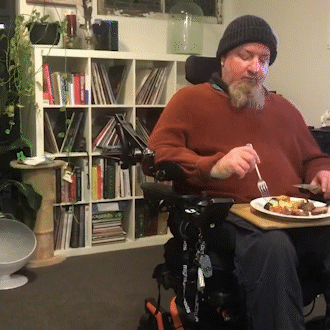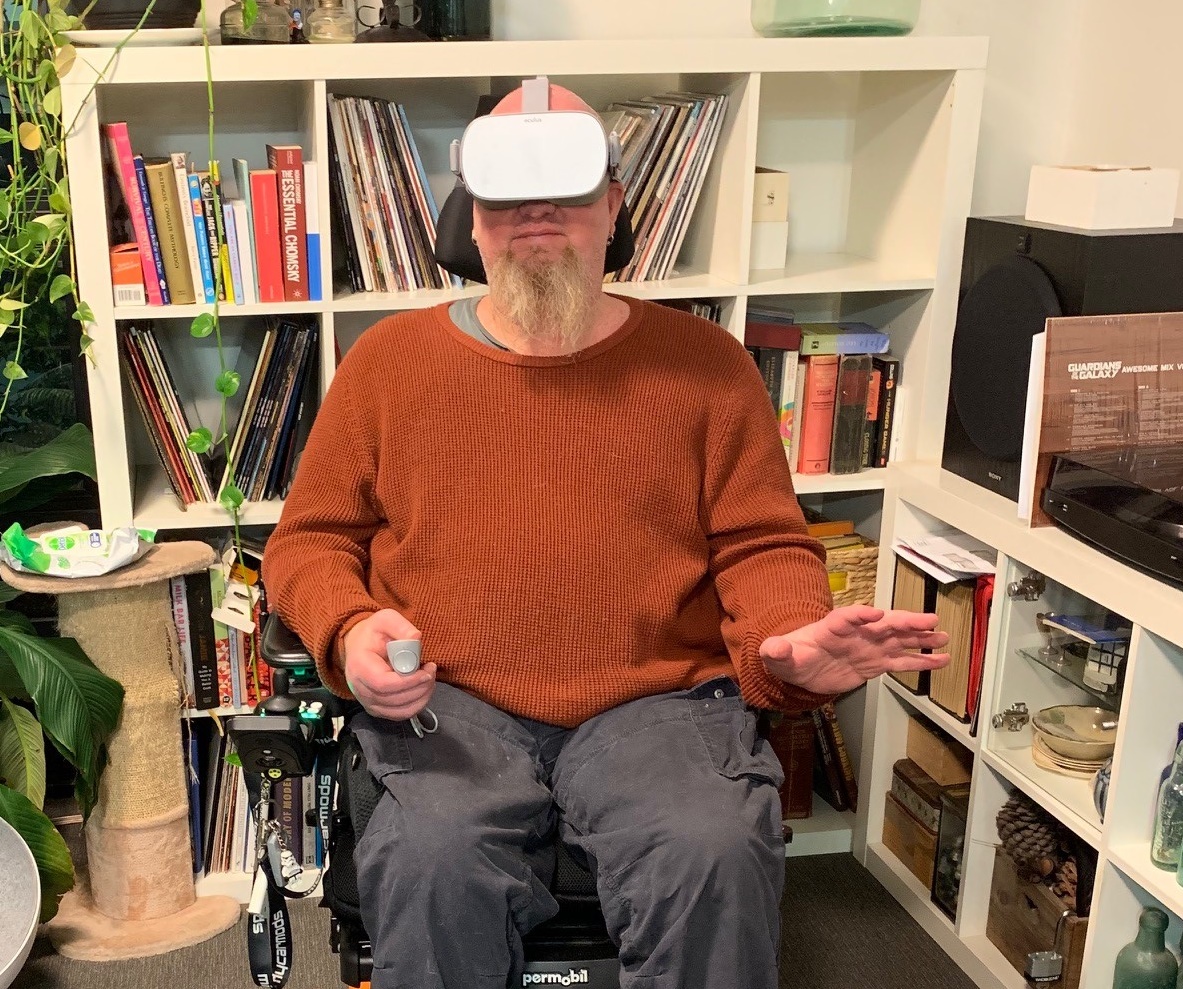This website uses cookies to improve your experience. We'll assume you're ok with this, but you can opt-out if you wish.
This mentality saw me resist the walking stick and hobble around unbalanced, then resist the wheelchair and crawl when I had fallen down, then resist pretty much everything that my much wiser occupational therapist suggested, like a shower commode or a hospital bed. I even resisted the transition from manual wheelchair to power chair. Each time I adopted a new piece of assistive technology part of me felt like I was surrendering something, but those feelings were quickly eclipsed by the realisation that the new piece of equipment allowed me to do so much more, often returning to me the freedom and independence that I had unknowingly lost while I was busy being stubborn.

When I started to search for assistive technology it was at a time before the NDIS, and so yes I found things that would or could make life easier, but they were usually prohibitively expensive. But now things have changed. In the past seven years I have found some amazing pieces of assistive technology that have taken away a great deal of stress and anxiety, so I’m going to walk you through a few of my favourite things and explain how they have helped in the hope that sharing might show you something that you have missed.
I have installed a ceiling hoist in my bedroom that uses a sling called an ambulating vest from Patient Handling in Marrickville. It is a thick belt that goes around the waist and buckles up. It is designed for gait training, it is designed to support your body weight while you walk on a treadmill or something similar as you build up leg strength and balance. I don’t use it for that, I am unable to stand or walk, I use an electric wheelchair 14 hours per day, I use the ambulating vest and ceiling hoist for all of my transfers. A thick belt goes around my waist and lifts me to a vertical standing position, I am able to be dressed and undressed, moved from bed to shower commode or bed to wheelchair etc, easily by one support worker that doesn’t have to do any heavy lifting. This is quite a feat considering that I’m 6’2 and 110kg. It’s quick, and means that I don’t have to be rolled on the bed during dressing. My ceiling hoist was around $7000.
Not all assistive technology needs to be expensive big ticket items, here are some low cost assistive technologies that you can acquire yourself – things that you won’t need NDIS or Aged Care funding to acquire.
Smart switches are a power switch that you plug into your existing wall socket that allows you to turn the power to a device on and off using your phone. For example, I have a smart switch plugged into my wall socket. It is connected by a WiFi signal to the internet modem in my house. My phone is also connected to the modem in my house using a WiFi signal. Each night during summer I am plugging a fan into that wall socket and use a smart switch to turn it on before I go to bed. During the night when I start to get cold, I can use my phone to turn off that smart switch – which also turns off the fan. I have also connected my TV and DVD player and stereo etc, to a power board, and the power board is then connected to a smart switch, when I go to bed at night I use my phone to power off those devices. I do this to reduce my electricity bill and to reduce the risk of an electrical fire during the night. I also have a smart switch that powers down my computer and printer etc for the same reason. You can program a smart switch to turn on and off at certain times, using an app that you download into your phone.
I have another smart switch that turns on my heater in the bathroom half an hour before I get up in winter. You can also buy smart light bulbs, they operate on the same principle but the switch is built into the bulb, this allows you to turn lights on and off using your phone. If you don’t use a phone, there are a range of devices called hubs, like “Google Home” that you can simply talk to and ask to turn your smart light bulbs or switches on and off. Smart switches are about $20 – $30, and you can use low cost AT funding from Core NDIS funding.
I have some difficulty regulating my body temperature, and so being able to open and close a window to allow air flow would be really beneficial for me. At a disability expo in Sydney a few years ago, I saw a device that allowed you to open a sliding door or sliding window using similar technology. A small electric spindle actuator is attached to the door or window, and once again is operated using a signal via your WiFi network. You can then use your phone or hub to open and close doors and windows if you’re too hot or cold, or if it starts to rain etc. The window opening mechanisms were around $150 – $300.
I have also stayed at Paraquad accommodation in Glenorchy Hobart in a unit that was fitted with electric blinds that were operated by remote control, allowing you to regulate the amount of sun coming in through the window.

I’ve recently been exploring two other types of assistive technology. The first one is the Armon Edero arm support. It’s a bit like a brace that attaches to your arm, then the brace attaches – in my case – to my wheelchair or a table. The brace has tensioned springs inside that help support the weight of your arm, like zero gravity, then with a smaller amount of muscle power you can wave your arm around, touch the top of your head, feed yourself more easily etc. I’m hoping to be able to use it to help me use a paintbrush again to paint paintings, as well as allowing me to shave, feed myself, and reach things that I’m having difficulty with at the moment. In my case this assistive technology item is being funded by the NDIS. The Armon Edero arm support through Active Mobility Systems around $5000-$6000, and that might seem like a lot of money, but it equates to 109 hours of paid support at $55 per hour, so if you think about how many things the arm might allow you to do independently over the course of a year, it pays for itself pretty quickly.
The other item I’d like to mention isn’t technically assistive technology, its virtual reality (VR). It is essentially a mask that you wear over your eyes that have goggles and a high resolution screen built in. It also has speakers built in for sound, and a simple remote control that you use with your hand, the headset I’m talking about is called the Oculus Go. It connects to the internet by WiFi signal, and it opens up an entire world of virtual experiences. It is predominantly geared towards video gaming, but there is also a decent amount of other content, such as 360 degree videos by National Geographic. Once you place the headset on and you’ve selected your experience or video, you find yourself in an environment that fully surrounds you.
The first video I watched was Antarctica, as I looked around I saw penguins, blue-green ocean, and a snow covered landscape that completely surrounded me. If I looked up I saw sky, if I turned my head the landscape changed as though I was actually standing there and looking around me. And, it’s 3D, so when those penguins get up close and personal, you flinch because your senses are telling you that you are actually in Antarctica, or surrounded by wolves in Yosemite National Park, or fishing for salmon in a river next to a grizzly bear. My headset was under $300, and there are a range of different headsets, with different prices and options, and more due to be released before Christmas 2020.
There are pros and cons with many of the headsets though and you have to find what is right for you. However, if the idea of being transported at the click of a button to Mexico where you are all of a sudden riding a horse along a beach at sunset appeals to you, then perhaps this is something you should look into. I did a lot of research before buying, and I had a lot of reservations, but at the end of the day I’ve experienced things through this headset that I couldn’t possibly experience in real life, and although it’s not exactly the same thing, I feel changed by the experience. I can spend half an hour or an hour feeling like I’m anywhere in the world.
I’d be happy to answer any questions on the virtual reality, or anything else I’ve talked about and you can contact me via MDNSW.
My name is Gordon Osmond, I am a retired acrylic and oil artist and I live in West Albury NSW. I have a debilitating neuromuscular condition called Inclusion Body Myositis or IBM.
Say hello & contact our friendly team today.
Email: info@mdnsw.org.au
Phone: (02) 9888 5711
Freecall: 1800 635 109
Phone: (02) 9888 5711
Freecall: 1800 635 109
Email: info@mdnsw.org.au
Postal Address: PO Box 3071, North Strathfield NSW 2137
Muscular Dystrophy NSW would like to acknowledge the Traditional Custodians of the land on which we live and work, and we pay our respects to their Elders past and present. We extend that respect to all Aboriginal and Torres Strait Islander peoples.
"*" indicates required fields